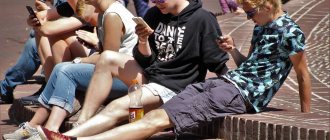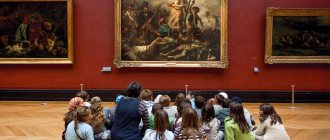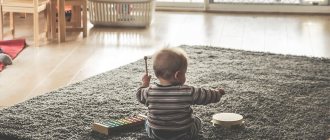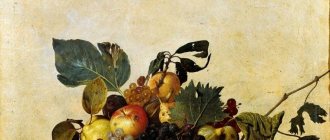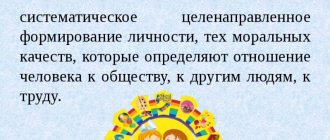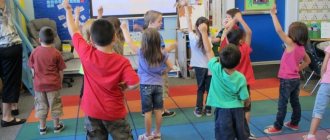In modern pedagogy and education of children, the aesthetic education of preschool children is of particular importance, designed to create all the prerequisites for the formation of a developed and harmonious personality. Without it, the child will not be able to appreciate beauty, receive true pleasure while listening to classical music or contemplating a painting, and even more so will not be able to create something of his own. He will become spiritually poor, boring, and will not be able to understand his emotions, because when he touches something beautiful, something inside him will respond, but he will not be able to understand what exactly. That is why parents should include this important aspect in their parenting tactics, without shifting all responsibility to preschool employees - the role of the family in the formation of personality is very great. For children of different ages, a variety of methods can be used and a variety of means can be used.
What it is?
The word “aesthetics” is of ancient Greek origin and means “sensory perception.” And aesthetic education is the development in a child of the ability to perceive, understand, and analyze beauty both in art and in everyday life, as well as the desire to create his own works.
Note that the words “beautiful” and “beautiful” are not synonymous, since the second concerns primarily form, external expression, while beauty can be found even in the most ordinary things, it includes harmony, spirituality, sublimity.
The desire to notice the beauty of the world around us and a love for works of art should be constantly and purposefully cultivated in a child from the first months of his life. It is important not to focus on the development of artistic and musical perception, but to set as a goal the formation of a harmonious personality.
In addition to its direct purpose, aesthetic education of children allows them to develop:
- thinking;
- imagination;
- memory;
- system of interests;
- perception;
- moral qualities;
- active attitude towards life.
And, of course, the child learns to understand art and strive to create his own works.
At home
From early childhood, children have a certain craving for beauty; they are attracted to brightly decorated toys, shiny and colorful objects. Kids get real pleasure listening to music or rhymes or fairy tales that their mother reads to them. These impulses, while unconscious, gradually become conscious, but only if the parents help the baby develop harmonious taste, creative and artistic abilities, and aesthetic ideas. This is the only way to ensure that the child’s personality is developed and he himself is happy.
In kindergarten
In preschool educational institutions, the work of cultivating the desire for beauty is also of enormous importance. For this, the necessary conditions must be created, certain forms of activities must be carried out - creating crafts, drawing, modeling, listening to classical works of art accessible to children and talking about what they have listened to. Therefore, aesthetic education of preschoolers is a task simultaneously facing parents and educators.
Projects within the framework of artistic and aesthetic development of preschool children
"How beautiful this world is"
Content part:
- “Art is a wonderful world of beauty.” Goals: introducing students to examples of works of art, developing skills in understanding the world of painting, developing the ability to express their aesthetic impressions, and developing speech.
- "Magic Flower" Collaborative painting with watercolors and wax crayons. Goals: Using various materials and visual techniques, to activate children’s free experimentation, develop creative imagination, imaginative thinking, and a sense of color. Teach non-traditional artistic techniques for depicting flowers.
- "Beautiful moments of summer." Monotype. Objectives: To teach the skills of depicting mirror-symmetrical prints. To familiarize children with the rules of drawing up a harmonious color composition and to improve the visual technique of watercolor.
- "The concept of still life." Objectives: To introduce the features and history of the development of the still life genre. Learn to correctly describe the thoughts and emotions that a painting evokes.
- "Autumn Foliage Ball" Semolina paintings with appliqué elements. Goals: organize and conduct a game in an art museum. To teach the ability to create pictures from semolina using paints, to develop a sense of color.
- "Scenery". Objectives: To introduce the features and history of the development of the landscape genre. Learn to correctly describe the thoughts and emotions that a painting evokes.
- "Autumn landscape". Fine technique of grisaille. Goals: mastering drawing with charcoal or sanguine, conducting experimental work with one color, achieving different shades.
Video: drawing with palms and fingers
“The World of Classical Music” (duration 1 year)
Plan.
- September. Acquaintance with the creative musical heritage of P.I. Tchaikovsky "Children's Album".
- October. Introduction to classical ballet as a genre of plastic art. "Sleeping Beauty", "Nutcracker".
- November. Discussion of the works of P.I. Tchaikovsky, the formation in children of the perception of dance movement as a way of conveying a musical image.
- December - January. Introduction to European classical music: Bach, Mozart, Beethoven.
- February. Conducting an integrated lesson in fine arts and music, learning to convey musical impressions and experiences in drawing.
- March, April. Acquaintance with the ancient dance tradition (minuet, gavotte).
- May. Final conversation for children and parents “Conversations about music.”
Video: “Music Day” project
Goal, objectives
The goal of this direction in education is the formation of an aesthetic culture in a person, which consists of the following aspects:
- Perception. This is the ability to notice various forms of manifestation of beauty, including in nature, work, and everyday life.
- Feelings. The ability to emotionally evaluate harmony and perfection.
- Needs. The desire to receive aesthetic pleasure, to contemplate works of art, the beauty of nature.
- Tastes. Ability to conduct assessments. Analysis of real world objects from an aesthetic position.
- Ideals. Individual ideas about what is perfect and harmonious in nature, people, and art.
The goal of aesthetic education is specified in a number of tasks:
- Developing in a child the ability to see beauty and appreciate it.
- Formation of a harmonious personality.
- Development of artistic taste.
- Formation of an aesthetic ideal, the desire to become beautiful not only externally, but also internally, in actions, thoughts, and deeds.
- Stimulating creative abilities and the desire for their development.
As a result of upbringing, a child must understand what harmony and perfection are, be able to empathize, be distinguished by emotional responsiveness, and imagination.
Facilities
Let's consider the means that parents can use to introduce their baby to the world of beauty. There are quite a lot of them:
- fine arts (sculpture, painting);
- dramaturgy;
- architecture;
- literature;
- music;
- TV;
- nature;
- MASS MEDIA.
Since teaching a child to notice and appreciate beauty is very difficult, you should use all available means.
Room decoration
For the little ones it is important to create a harmonious environment in the room:
- Create harmony and comfort in your baby's room.
- It is preferable to use light colors in the design.
- The space should not only be ergonomic, but thoughtful.
The room should be beautifully arranged with toys, interesting reproductions should be hung, and it should be kept clean and tidy. Flowering plants placed in a harmonious composition and a decorated aquarium with fish will also help you achieve your goal. All decorative elements must be combined with each other, forming a single ensemble.
For children of primary preschool age, you can choose a painting depicting an animal, a familiar fairy-tale character, or a “delicious” still life. Older children will like the landscape, so it is better to use reproductions of Savrasov, Serov, Shishkin, Levitan. To prevent the child from losing interest, the paintings should be changed periodically, while telling the child information about the work itself and its author.
In addition, the children's room can be decorated with folk crafts, Dymkovo toys, and Khokhloma crafts. Of course, you shouldn’t place expensive collectibles on the table of a young prankster, but something inexpensive made of ceramics can become a worthy decoration.
Nature
From an early age, parents need to instill in their child that trees and flowers, sunset and sunrise, clouds in the sky and waves in the river are beautiful, they need to be taught to enjoy this beauty. To do this, you should introduce children to works about nature that are accessible to them, spend time in the fresh air, talk, answer questions, and set your own example.
Art
A lot can be used to educate children aesthetically. So, in any city there are beautiful streets, architectural buildings, museums, and exhibitions are held. Preschoolers enjoy learning something new by visiting such places. Walking around the city, you can introduce your child to the main attractions, paying attention to their sophistication and harmony.
If there are no museums in the city, reproductions and virtual excursions, which can be viewed via the Internet, will help introduce your child to works of art. It is necessary to include outstanding musical works for the little ones, talk about what they listened to, find out what thoughts and emotions were evoked by the music of Beethoven or Mozart, Tchaikovsky and Rachmaninov.
And, of course, we should not forget about literary works. Preschoolers can understand Pushkin's fairy tales, especially if they look at high-quality color illustrations. You should also introduce them to the poems of Marshak, Barto, and the stories of Prishvin and Zhidkov.
It is important for parents to remember that not every child will become an artist or musician, but everyone should be able to feel the beautiful and receive special pleasure from it. Therefore, you should not just ask your child to draw something or make a craft or appliqué, but also pay attention to already created objects of spiritual value.
Work
When carrying out the tasks of aesthetic education of children, you should introduce them to the benefits of work, tell them that there are a large number of professions, each of which is important.
Activities to develop abilities in preschool age
There is a huge variety of creative activities that contribute to the development of artistic perception of preschoolers, who vary in age and type of creativity.
Classes for 3-4 years
REFERENCE! At this age, babies are just learning to express a positive reaction when they see familiar objects. They are not yet ready to perceive an artistic image, but choose certain pictures simply because they like them or resemble familiar objects.
One of the effective ways to develop artistic and aesthetic skills in children of primary preschool age is unconventional drawing. This provides an incentive to develop the ability to think outside the box and experiment. The arsenal of unconventional drawing is very diverse:
- Drawing with stencils - in this case, paint is applied to a pre-prepared stencil using a variety of tools: a sponge, a brush, a roller or even ordinary rags.
- Drawing with stamps, palms, leaves, cotton swabs, etc. - in this case, paint is applied to a stamp or something that replaces it and an impression is made on paper. Prints can be formed into patterns, and you can experiment with color.
- Drawing on wet paper differs from regular drawing in that paint is applied to a pre-moistened sheet and it spreads, creating unexpected patterns. At the same time, the child learns to follow what happens and guide the drawing process.
Modeling from plasticine not only forms artistic and aesthetic perception, but also promotes the development of fine motor skills, which is very important in preschool age. To deepen the effect of these activities, plasticine figures sculpted by children are used to dramatize fairy tales.
IMPORTANT! Musical classes can be either an independent form of creativity or accompany the creative process in other directions. For example, when a teacher turns on music while drawing or sings songs with children while dramatizing fairy tales.
Classes for 5-7 years old
REFERENCE: At the age of 5, a child is already able to receive aesthetic pleasure from contemplating a painting, but for him the color scheme is more important than the composition. At the age of 6-7 years, perception becomes much more subtle, children capture the inner mood of the image.
At this age, the possibilities for creative activities with children expand, as the children’s abilities also expand.
Older preschoolers have more complex skills and can complete more complex tasks.
For example, children 6-7 years old can engage in floristry, quilling, papermaking, etc.
Floristry is the creation of compositions from plant materials. It requires the child to be able to see the image, select the necessary shapes and shades of colors, and carefully work with fragile material.
For work, you can use leaves, flowers, twigs, moss and other plant materials.
Quilling is the making of pictures from rolled strips of paper. This is a rather painstaking task that requires patience and perseverance. Artistically, children learn to compose a composition and select colors.
Papermaking is an excellent tool for developing imaginative thinking. By making three-dimensional models from paper, preschoolers solve design problems, show imagination and aesthetic taste. Additionally, paper craft activities can be complemented by storytelling, drama, and other forms of creative development.
IMPORTANT! In older preschool age, children begin to get acquainted with the masterpieces of world artistic culture - paintings, architecture, literature (fairy tales, poems), etc. This happens in the form of conversations, viewing photographs, and reading.
Methods
Methods of aesthetic education of preschool children include:
- personal example of parents and educators.
- conversations;
- classes held in kindergarten and then at school;
- additional classes in clubs and sections of interest;
- visiting exhibitions and museums.
The most effective method is considered to be the first, personal example, which includes both appearance and behavioral characteristics, and moral attitudes. Looking at parents and educators who understand beauty and enjoy contemplating it, the child himself will want to become the same. Only in this way can an ideal be formed, which will later form the basis of the child’s artistic consciousness.
Based on the method of transmitting information, methods can be divided into 2 groups:
- Visual. Showing a child a work of art or folk craft.
- Verbal. A story about a particular artist, a painting, an explanation of what exactly the author wanted to express in his work.
Both groups are important. The first allows you to get an idea, the second allows you to understand your own feelings. In any case, it is necessary to focus on age characteristics and select material that is understandable to the baby.
Principles
Let's consider the basic principles of aesthetic education of preschoolers:
- It should be carried out in close connection with educational and educational work.
- Various forms and methods of artistic activity should be used.
- Each child needs to be approached individually; all children are different. What one person likes may cause boredom to another.
- The work must be carried out purposefully. At the same time, you should not allocate any special time for the aesthetic development of the baby; it should be carried out constantly.
It is necessary to focus on common values, to cultivate in the child love and respect for national culture and traditions.
Forms and methods of artistic and aesthetic development of preschool children
Galina Zhuravleva
Forms and methods of artistic and aesthetic development of preschool children
Consultation for parents
In modern society, social and economic changes are taking place. This also affects education, which is at the stage of modernization in connection with the “Federal State Standards for the Structure of the Basic General Education Program of Preschool Education .”
The formation of a creative personality is one of the most important tasks of pedagogical theory and practice at the present stage. The man of the future must be a creator, with a developed sense of beauty and active creativity.
The modern concept of preschool education shows the importance of introducing children to art from an early age , considering it a measure of human values.
Changes in content, complication of the functions of modern preschool educational institutions and educational conditions have caused the need to search for new forms and methods of organizational and pedagogical activity.
That is why many kindergartens pay great attention to the artistic and aesthetic development of pupils .
In our time, the problem of artistic and aesthetic education , personal development , the formation of its aesthetic culture is one of the most important tasks facing education in general and preschool education in particular.
Pedagogy defines the artistic and aesthetic education of preschool children as a purposeful process of forming a creatively active personality of a child, capable of perceiving and appreciating the beauty in life and art.”
Thus, artistic and aesthetic education is the formation in a person of an artistic and aesthetic attitude to reality and its activation to creative activity according to the laws of beauty.
Artistic and aesthetic education should form artistic taste , develop and improve in a child the ability to aesthetically perceive beauty in art and in life, the ability to correctly understand and evaluate it.
Artistic and aesthetic education has an active and creative orientation, which should not be limited only to a contemplative task, it should form the ability to create beauty in art and life.
Communicating with the aesthetic phenomena of life and art, the child develops aesthetically and artistically . But at the same time, the child is not aware of the aesthetic essence of objects , and development is often determined by the desire for entertainment and without outside intervention the child may develop incorrect ideas about life, values, and ideals.
Academician Likhachev, like many other teachers and psychologists, believes that only targeted pedagogical aesthetic and educational influence, involving children in a variety of artistic and creative activities can develop their sensory sphere , provide a deep understanding of aesthetic phenomena, and raise them to an understanding of true art and beauty. reality and beauty in the human personality.
The essence of this process can be defined as follows:
Firstly, this is the process of purposefully cultivating a sense of beauty.
Secondly, it is the formation of the ability to perceive and see beauty in art and life, and appreciate it.
Thirdly, the task of artistic and aesthetic education is to form artistic taste .
And, finally, fourthly, the development of the ability to create independently and create beauty, the development artistic products .
The main thing is to educate and develop such qualities , such abilities that will allow the individual not only to achieve success in any activity, but also to be the creator of aesthetic values, to enjoy them and the beauty of the surrounding reality.
In addition to the formation of children’s artistic and aesthetic attitude towards reality and art, artistic and aesthetic education simultaneously contributes to their comprehensive development . It contributes to the formation of a person’s morality, expands his knowledge about the world, society and nature. A variety of creative activities for children contribute to the development of their thinking and imagination, will, perseverance, organization, and discipline.
Tasks:
the first is the creation of a certain stock of elementary aesthetic knowledge and impressions, without which inclination, craving, and interest in aesthetically significant objects and phenomena cannot arise. The essence of this task is to accumulate a diverse stock of sound, color and plastic impressions. The teacher must skillfully select, according to the specified parameters, such objects and phenomena that will meet our ideas about beauty.
In this way, a sensory-emotional experience will be formed . Specific knowledge about nature, oneself, and the world of artistic values ;
the second task of artistic and aesthetic education is “ the formation , on the basis of acquired knowledge and the development of the abilities of artistic and aesthetic perception, of such socio-psychological qualities of a person that provide her with the opportunity to emotionally experience and evaluate aesthetically significant objects and phenomena, enjoy them”;
The third task of artistic and aesthetic education is related to the formation of artistic and aesthetic creativity in each student
The main thing is to “educate and develop such qualities , needs and abilities of the individual that turn an individual into an active creator, creator of aesthetic values, allow him not only to enjoy the beauty of the world, but also to transform it “according to the laws of beauty.” The essence of this task is that the child must not only know beauty, be able to admire and appreciate it, but he must also actively participate in the creation of beauty in art and life, and independently create creative products.
Most researchers distinguish the following categories: aesthetic perception, aesthetic taste, the formation of an aesthetic ideal and aesthetic evaluation.
Preschool age is the most important stage in the development and education of the individual, the most favorable for the formation of artistic and aesthetic culture , since it is at this age that positive emotions predominate in the child, special sensitivity to linguistic and cultural manifestations, personal activity appear, and qualitative changes occur in creative activity.
Aesthetic education of the individual occurs from the first steps of a little person, from his first words and actions. The effectiveness of aesthetic education directly depends on compliance with the principle of artistic and creative activity and amateur performances of children . Choral singing, folk dancing, playing instruments, writing songs, poems, stories, theatrical performances introduce children to works of art, polish their performing skills, become the content of spiritual life, a means of artistic development , individual and collective creativity, and self-expression of children . According to the theory of A.V. Zaporozhets, the main path of child development during preschool childhood is amplification of development , that is, enrichment, filling with the most significant for the child, specifically children's preschool forms , types and methods of activity. that are closest and most natural to a child - a preschooler - play, communication with adults and peers, experimentation, object-based, visual, artistic and theatrical activities, child labor and self-service - occupy a special place in the system of artistic and aesthetic education . But it is artistic activity , saturated with amplification, brightly and emotionally colored from the satisfaction received from engaging in favorite types of artistic activity , that helps, without forcing the child with dry didactics, to achieve by the age of seven the same results as intellectual programs. And, moreover, as a result of artistic and aesthetic education - a spiritually rich, comprehensively developed personality . That is why it is necessary to pay great attention to the artistic and aesthetic development of students . One of the main goals of the teaching staff should be the development of the child’s creative potential and the creation of conditions for his self-realization. To obtain the expected results in a preschool artistic and aesthetic education must be created , which consists of interconnected components: updating the content of education (selection of programs and technologies)
;
creating conditions for aesthetic education (staffing, educational, methodological and logistical support, creating a subject- development environment , creating a harmonious design of the territory and premises of the kindergarten); organizing the educational process (working with children and parents)
; coordination of work with other institutions and organizations.
The system of pedagogical interaction between teachers and children , aimed at the artistic and aesthetic development of preschool children , is being built in preschool educational institutions in three directions:
— specially organized training;
— joint activities of teachers and children ;
- independent activity of children .
The interaction between teachers and children is carried out taking into account a differentiated approach and includes various forms of work : group and subgroup classes, holidays, entertainment , themed musical evenings, creativity weeks, didactic games, exhibitions of drawings and crafts, the creation of homemade books, group and studio work; free artistic activity ; organization of performances, entertainment , competitions, exhibitions, festivals, holidays; museum pedagogy; aesthetic design of interiors ; participation in city events, etc.
The knowledge gained in the aesthetic cycle classes is reflected in the play activities of the students. They enjoy playing music, showing mini-performances, dancing, retelling fairy tales, and doing their own writing.
Program " Artistic and Aesthetic Education "
in preschool educational institutions includes introducing
children to art , aesthetics of the developmental environment , visual activities (drawing, modeling, appliqué, design and manual labor, musical education, cultural and leisure activities. synthesis of arts; vocals; choreography, theatrical and gaming activities; all types of productive activities , local history
The implementation of the tasks of artistic and aesthetic education will most optimally be carried out under the following conditions:
• Maximum consideration of the age and individual characteristics of children .
• The basis of artistic and aesthetic education is art and the surrounding life.
• The relationship between the artistic and creative activities of children themselves and educational work, which provides a variety of food for the development of perception , imaginative ideas, imagination and creativity.
• Integration of various types of art and various types of artistic and creative activities , promoting a deeper aesthetic understanding of reality, art and one’s own artistic creativity ; the formation of figurative ideas, figurative, associative thinking and imagination.
• Respectful attitude towards the results of children's , wide inclusion of their works in the life of a preschool educational institution.
• Organization of exhibitions, concerts, creation of an aesthetic , etc.
• Variability of content, forms and methods of working with children in different areas of aesthetic education.
• Ensuring continuity in artistic and aesthetic education between all age groups of kindergarten, as well as between kindergarten and primary school.
Close relationship and interaction between kindergarten and family.
• Wide reliance on regional material, its specificity: nature, art - both classical and folk. Acquaintance with contemporary art and its creators working in a village, city, region. Children’s knowledge of the sights, their surroundings, and significant events.
The conditions for artistic and aesthetic education are very diverse. They depend on many conditions: the volume and quality of artistic information , forms of organization and types of activities, and the age of the child . The basis of aesthetic education is the joint activity of an adult and a child to develop his creative abilities for the perception of artistic values , for productive activity, and a conscious attitude towards the social, natural, and objective environment. Aesthetic perception of life phenomena is always individual and selective. It is based on an emotional response to beauty. A child always responds to the beautiful in nature, the objective world, art, and to the kind feelings of people. The child’s personal experience, his motives, aspirations, and experiences are of great importance.
The artistic and aesthetic development of preschool children is carried out directly in educational areas: “Cognition”
,
“Communication” “Reading
fiction ” ,
“
Artistic creativity ” ,
“Music”
.
The key role of a kindergarten is to create conditions for the formation of a harmonious , spiritually rich, intellectually developed personality .
It all depends on the first preschool experience that the child will receive within the walls of the preschool institution , on the adults who will teach the child to love and perceive the world around him, to understand the laws of society, the beauty of human relationships.
Introducing children to art is exactly the “key”
, which reveals the creative potential in children and gives them a real opportunity to adapt to the social environment.
Among the methods of artistic and aesthetic education, the following can be distinguished:
a method of inducing empathy, emotional responsiveness to the beautiful and condemnation of the ugly in the world around us. This method assumes that works of art must be highly artistic , and when children listen to poetry, fairy tales, and music, it is important not only for the teacher to accurately reproduce the text or musical design, but also for its emotional and imaginative performance. Only in this case can an educational effect be achieved;
The method of persuasion allows children to develop aesthetic perception and elements of artistic taste . The peculiarity of this method is that it can be used only when the perceived phenomenon is beautiful;
training method , exercises in practical actions;
method presupposes the child's desire to decorate and improve the environment, that is, to transform it as much as possible and please his peers and adults with this;
method of search situations , encouraging children to be creative. Using this method , the teacher invites children to come up with a story, draw, sculpt according to plan, etc.
Works of art must be present in the educational process.
The first direction is that art, including folk art, is included in the daily life of children as an integral part of the aesthetic environment.
So, music can be played in and outside of classes, and works of fine art can be used in the design of a preschool institution .
The second direction is that art constitutes the content of education: children are introduced to different types of art, events, phenomena, objects revealed by artists , musicians, writers and poets in their works; with expressive means that allow you to create vivid images of reality.
The third direction is that art is used in various types of artistic activities and serves the development of children's artistic creativity . Images of art are standards of beauty.
The implementation of the curriculum for the artistic and aesthetic development of preschool children requires educators and specialists to constantly improve their pedagogical skills.
Thus, a properly organized system of work on the artistic and aesthetic education of children - the creation of conditions for aesthetic education, the organization of the educational process will create favorable conditions for children's artistic and aesthetic abilities , creative imagination and, as a result of artistic and aesthetic education , spiritual a rich, well- rounded personality .
Specifics of upbringing in the family
We have already noted that you should not rely solely on preschool educational institutions, entrusting educators with the aesthetic development of the baby. It is also important for parents to put some effort into this. Let's pay attention to the following points:
- Parents should always look neat and tidy and behave respectfully towards each other, since the child takes a lot from them.
- It is important to read good literature, fairy tales and poems to your child, and be sure to talk about the content of what you read. This form of work also helps to enrich the baby’s vocabulary.
- Together with your child you can draw, make applique or crafts. To prevent your baby from getting bored, you can use various artistic techniques, drawing with gouache, watercolors, crayons, and felt-tip pens.
- The aesthetics of everyday life are also important. If the apartment is dirty and not cleaned, there can be no question of any desire for perfection. Therefore, you need to decorate the children's room with taste and love.
- The formation of musical taste begins with listening to nursery rhymes, lullabies, and children's songs.
Of particular importance are conversations that will help the child get answers to the questions he has, learn to distinguish the beautiful from the disgusting, the sublime and harmonious from the base and chaotic.
Let us outline the most important conditions for the development of children's creativity:
- Relaxed atmosphere. You should not put pressure on your child and force him to draw or sculpt, this will only destroy his desire to create his own works.
- Active use of game forms of work.
- Praise should be given constantly; it is important for the child to understand that his mother is pleased with him and is proud of his efforts. But you shouldn’t scold; in some cases you can scold a little.
Only in this case will it be possible to achieve positive results - the desire for one’s own creative pursuits and respect for the works of others.
Features of the development of technical creativity in preschool children
Technical creativity teaches a preschool child not only perseverance and patience, but also helps to develop certain abilities:
- The ability to find non-standard solutions to the tasks assigned to them and select a means for these solutions.
- Plan your activities.
- Compare, find differences and similarities, generalize.
- Select parts and combine them into a whole.
- Analyze your actions step by step, draw conclusions, give an account of your actions, assume further options for the development of events, correct shortcomings, identify advantages and use them in the future.
Classes on theatrical activities in secondary groups of the Children's Center
In addition, preschoolers learn to interact with each other, gain experience working in a team, learn to negotiate, look for a way out of the current situation, and develop their imagination.
Note ! The main type of activity of a preschooler according to the Federal State Educational Standard is play, which is inextricably linked with a toy. One follows from the other: a toy gives rise to play activity, and by developing play activity, it attracts new toys. Therefore, it is better to engage in technical creativity with little ones through play. The game helps to captivate the preschooler, interest him and achieve the desired result.
The best option for technical creativity of kids are:
- magnetic constructors;
- building kits;
- various cubes;
- block constructors;
- modeling kits;
- constructors with joint fastening;
- bolt-on constructors.
Innovative technologies in preschool educational institutions to unlock the creative potential of preschoolers
Innovative technologies in kindergarten are the use of modern components to improve the educational process.
The main types of innovative technologies in preschool educational institutions include:
- Project activities. The project is developed together with the teacher, helps the preschooler acquire new knowledge and systematize existing knowledge. The projects themselves are classified according to several criteria.
- Personality-oriented technologies. The teacher’s task is to select methods, games and activities that allow a particular child to develop as much as possible.
- Information and communication technologies. Consists of using personal computers, projectors, tablets, interactive whiteboards and other things in the classroom. The technology helps to attract kids. They are developing new skills. With it you can watch educational videos, films, cartoons. Improves educational process and presentation.
- Health-saving technologies. They consist of conducting thematic conversations, morning exercises, physical education sessions, sports festivals and other sporting events.
- Research activities. A research paper is similar to a course project. Teaches a preschooler to explore the world around him, understand the task at hand, find the problem and give it a definition. The main activity in this case is an experiment that contributes to the development of the baby’s thinking.
- Corrective technologies. Aimed at relieving emotional tension in the group. Relaxing music, color therapy, special games and exercises can be used.
- Gaming technologies. They occupy a dominant role due to the fact that play is the main activity of preschool children. At the same time, the game has a cognitive and developmental function.
The artistic and aesthetic development of a preschooler helps to make the child a comprehensively developed personality, capable of appreciating and seeing the beauty around him, and creating beauty with his own hands.
Events in libraries
Nowadays, libraries are undeservedly forgotten and are not particularly popular. Meanwhile, it is here that quite interesting events are often held, aimed at shaping and developing children’s artistic taste. Their additional advantage is that visiting is free. Please note that such events will be of interest to older children - older preschoolers and younger schoolchildren.
Attending library evenings, meetings and presentations will teach your child to love books and respect the written word; visiting thematic exhibitions will allow you to determine your own interests. And the literary and poetry evenings held will introduce the work of poets and writers.
Tips and tricks for parents
It is important to carry out aesthetic education of the child by all available means, creating a harmonious environment for him, giving him the opportunity to independently engage in artistic creativity in the chosen direction. Parents need to talk with the baby and give answers to all the questions he has. And classes with a teacher will help develop taste.
When choosing forms of work, you should focus on the age of the baby:
- Visiting the theater is permissible from 1.5 years of age; the repertoire of puppet theaters includes short-lasting productions that will not have time to tire the baby.
- You can talk about paintings, musical works, and talk about their authors from the age of 3–4; children already understand a lot and will definitely listen with interest and ask questions.
- At 4–5 years old you can visit an exhibition, including a library one.
- At 5-6 years old - go to the Philharmonic or ballet.
Giving a child the opportunity to create is another method of aesthetic education, and he can choose the type of activity to his liking. Some people like to draw pictures in the sand, while others like to write short congratulatory poems for mom or dad. Parents should not limit creative impulses, but give their child the freedom to choose and realize their own ideas.
Do not underestimate the importance of aesthetic education for preschoolers; it will help to spiritually enrich the child’s personality, make him developed, rich, able to feel subtly and receive aesthetic pleasure.
